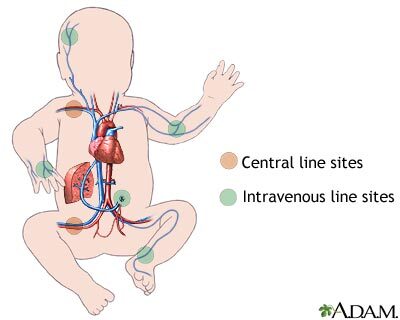Total parenteral nutrition - infants
Definition
Total parenteral nutrition (TPN) is a method of feeding that bypasses the gastrointestinal tract. Fluids are given into a vein to provide most of the nutrients the body needs. The method is used when a person cannot or should not receive feedings or fluids by mouth.
Alternative Names
IV fluids - infants; TPN - infants; Intravenous fluids - infants; Hyperalimentation - infants
Information
Sick or premature newborns may be given TPN before starting other feedings. They may also have this type of feeding when they cannot absorb nutrients through the gastrointestinal tract for a long time. TPN delivers a mixture of fluid, electrolytes, sugars, amino acids (protein), vitamins, minerals, and often lipids (fats) into an infant's vein. TPN can be lifesaving for very small or very sick babies. It can provide a better level of nutrition than regular intravenous (IV) feedings, which provide only sugars and salts.
Infants who get this type of feeding must be watched carefully to make sure they are getting the proper nutrition. Blood and urine tests help the health care team know what changes are needed.
HOW IS TPN GIVEN?
An IV line is often placed in a vein in the baby's hand, foot, or scalp. A large vein in the belly button (umbilical vein) may be used. Sometimes a longer IV, called a central line or peripherally-inserted central catheter (PICC) line, is used for long-term IV feedings.
WHAT ARE THE RISKS?
TPN is a major benefit for babies who cannot get nutrition in other ways. However, this type of feeding can result in abnormal levels of blood sugars, fats, or electrolytes.
Problems can develop due to use of the TPN or IV lines. The line may move out of place or clots may form. A serious infection called sepsis is a possible complication of a central line IV. Infants who receive TPN will be closely monitored by the health care team.
Long-term use of TPN may lead to liver problems.
Gallery

References
American Academy of Pediatrics (AAP) Committee on Nutrition. Parenteral nutrition. In: Kleinman RE, Greer FR, eds. Pediatric Nutrition Handbook. 8th ed. Elk Grove Village, IL: American Academy of Pediatrics; 2019:chap 22.
Maqbool A, Bales C, Liacouras CA. Intestinal atresia, stenosis, and malrotation. In: Kliegman RM, St. Geme JW, Blum NJ, Shah SS, Tasker RC, Wilson KM, eds. Nelson Textbook of Pediatrics. 21st ed. Philadelphia, PA: Elsevier; 2020:chap 356.
Poindexter BB, Martin CR. Nutrient requirements/nutritional support in the premature neonate. In: Martin RJ, Fanaroff AA, Walsh MC, eds. Fanaroff and Martin's Neonatal-Perinatal Medicine. 11th ed. Philadelphia, PA: Elsevier; 2020:chap 41.